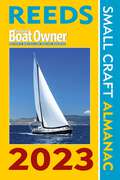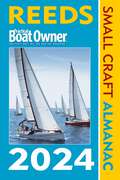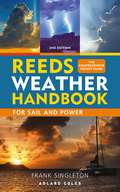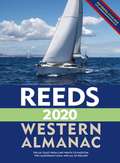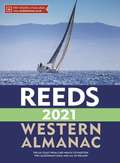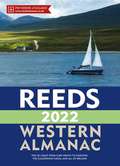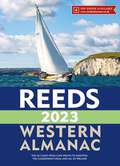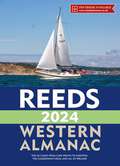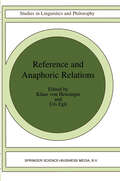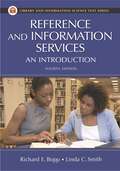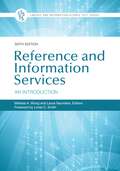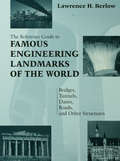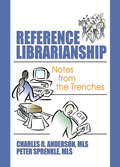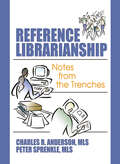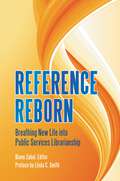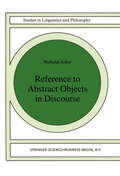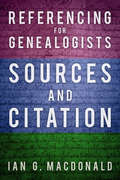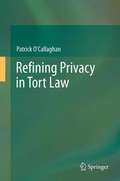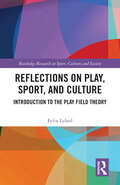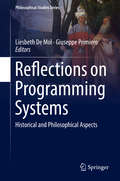- Table View
- List View
Reeds PBO Small Craft Almanac 2023 (Reed's Almanac)
by Perrin Towler Mark FishwickIn a practical handy format the Reeds PBO Small Craft Almanac, published in association with Practical Boat Owner, covers the North Atlantic coastline from Denmark to the Gironde.The Reeds PBO Small Craft Almanac may be more compact and concise than the Reeds Nautical Almanac but it contains a wealth of indispensable navigational data specially tailored for small craft sailors, presented in an easy to find, quick reference manner for on-board use. Streamlined to focus on tidal data (tide tables, tidal streams and tidal curves) and lights, buoys and waypoints, the Small Craft Almanac covers the whole of the UK and Ireland and the west coast of Europe from Denmark to the Gironde.Published in association with Practical Boat Owner magazine, this practical handy Almanac boasts many unique features for small craft sailors and represents excellent value for money for those who don't need the more comprehensive marina data, passage information and chartlets of the full Reeds Almanac.Meticulously researched, it includes a huge amount of information of value to small craft navigators: tide tables, tidal streams and tidal gates; secondary port differences; 2,500+ waypoints; radio data; light recognition; weather information; principal lights; IALA buoyage; international codes and flags; sun/moon rise/set times; emergency information.Also available: free supplements of up-to-date navigation changes from January to June at: www.reedsnauticalalmanac.co.uk
Reeds PBO Small Craft Almanac 2024 (Reed's Almanac)
by Perrin Towler Mark FishwickIn a practical handy format the Reeds PBO Small Craft Almanac, published in association with Practical Boat Owner, covers all of the UK and Ireland, as well as the North Atlantic coastline from Denmark to the Gironde.The Reeds PBO Small Craft Almanac may be more compact and concise than the Reeds Nautical Almanac but it contains a wealth of indispensable navigational data specially tailored for small craft sailors, presented in an easy-to-find, quick-reference manner for on-board use. Streamlined to focus on tidal data (tide tables, tidal streams and tidal curves) and lights, buoys and waypoints, the Small Craft Almanac covers the whole of the UK and Ireland and the west coast of Europe from Denmark to the Gironde.Published in association with Practical Boat Owner magazine, this practical handy Almanac boasts many unique features for small craft sailors and represents excellent value for money for those who don't need the more comprehensive marina data, passage information and chartlets of the full Reeds Almanac.Meticulously researched, it includes a huge amount of information of value to small craft navigators: tide tables, tidal streams and tidal gates; secondary port differences; 2,500+ waypoints; radio data; light recognition; weather information; principal lights; IALA buoyage; international codes and flags; sun/moon rise/set times; emergency information.Also available: free supplements of up-to-date navigation changes from January to June at: www.reedsnauticalalmanac.co.uk
Reeds Weather Handbook: For Sail And Power
by Frank SingletonWeather determines when we sail, where we sail to – and whether we arrive safely. This essential pocket-sized guide equips the reader with all the necessary tools to predict and deal with local and distant weather conditions, whether on a day trip or a longer cruise, along the coast or further offshore.Each topic is broken down into digestible chapters, explaining the origins and effects of the full spectrum of weather conditions, including:- using and evaluating weather forecasts- depressions, fronts, isobars and other coastal effects- waves and swell- weather lore and sky watching. Meteorology is still advancing and sources of forecasts are changing. This new edition keeps the handbook up-to-date, with a particular focus on the increasing use of GRIB files, computer weather modelling and sources of forecasts, especially with the proliferation of computer forecasts becoming available free of charge.With practical explanations and helpful diagrams and photographs, this is the ideal aide-memoire for skippers and crew, especially those studying for their Day Skipper and Yachtmaster exams.
Reeds Weather Handbook
by Frank SingletonWeather determines when we sail, where we sail to – and whether we arrive safely. This essential pocket-sized guide equips the reader with all the necessary tools to predict and deal with local and distant weather conditions, whether on a day trip or a longer cruise, along the coast or further offshore.Each topic is broken down into digestible chapters, explaining the origins and effects of the full spectrum of weather conditions, including:- using and evaluating weather forecasts- depressions, fronts, isobars and other coastal effects- waves and swell- weather lore and sky watching. Meteorology is still advancing and sources of forecasts are changing. This new edition keeps the handbook up-to-date, with a particular focus on the increasing use of GRIB files, computer weather modelling and sources of forecasts, especially with the proliferation of computer forecasts becoming available free of charge.With practical explanations and helpful diagrams and photographs, this is the ideal aide-memoire for skippers and crew, especially those studying for their Day Skipper and Yachtmaster exams.
Reeds Western Almanac 2020 (Reed's Almanac)
by Perrin Towler Mark FishwickThe Reeds Western Almanac covers the coastline from Cape Wrath to Padstow as well as the whole of Ireland, and is ideal for any boater lucky enough to cruise and race in the superb waters off the coast of Western Scotland, Ireland or Western England. It offers ready access to essential navigation information by virtue of its clear layout and user friendly format.Completely updated for 2020, topics include seamanship, pilotage, tide tables, safety procedures, navigation tips, radio, lights, waypoints, weather forecast information, communications, Mayday and distress procedures. The spiral binding allows the Almanac to be opened flat on the chart table and the large type size and clear layout makes information easy to read even in adverse conditions. It is the complete guide for both Irish and Scottish mariners as well as those cruising the UK west coast.Includes a free Reeds Marina Guide.Also available: free supplements of up-to-date navigation changes from January to June at: www.reedsnauticalalmanac.co.uk'There are some things I would not go to sea without - Reeds is one of them.'Sir Chay Blyth
Reeds Western Almanac 2021 (Reed's Almanac)
by Perrin Towler Mark FishwickThe Reeds Western Almanac covers the coastline from Cape Wrath to Padstow as well as the whole of Ireland, and is ideal for any boater lucky enough to cruise and race in the superb waters off the coast of Western Scotland, Ireland or Western England. It offers ready access to essential navigation information by virtue of its clear layout and user friendly format.Completely updated for 2021, topics include seamanship, pilotage, tide tables, safety procedures, navigation tips, radio, lights, waypoints, weather forecast information, communications, Mayday and distress procedures. The spiral binding allows the Almanac to be opened flat on the chart table and the large type size and clear layout makes information easy to read even in adverse conditions. It is the complete guide for both Irish and Scottish mariners as well as those cruising the UK west coast.Includes a free Reeds Marina Guide.Also available: free supplements of up-to-date navigation changes from January to June at: www.reedsnauticalalmanac.co.uk'There are some things I would not go to sea without - Reeds is one of them.'Sir Chay Blyth
Reeds Western Almanac 2022 (Reed's Almanac)
by Bloomsbury PublishingThe Reeds Western Almanac covers the coastline from Cape Wrath to Padstow as well as the whole of Ireland, and is ideal for any boater lucky enough to cruise and race in the superb waters off the coast of Western Scotland, Ireland or Western England. It offers ready access to essential navigation information by virtue of its clear layout and user friendly format.Completely updated for 2022, topics include seamanship, pilotage, tide tables, safety procedures, navigation tips, radio, lights, waypoints, weather forecast information, communications, Mayday and distress procedures. The large type size and clear layout makes information easy to read even in adverse conditions. It is the complete guide for both Irish and Scottish mariners as well as those cruising the UK west coast.Includes a free Reeds Marina Guide.Also available: free supplements of up-to-date navigation changes from January to June at: www.reedsnauticalalmanac.co.uk'There are some things I would not go to sea without - Reeds is one of them.'Sir Chay Blyth
Reeds Western Almanac 2023 (Reed's Almanac)
by Perrin Towler Mark FishwickThe Reeds Western Almanac covers the coastline from Cape Wrath to Padstow as well as the whole of Ireland, and is ideal for any boater lucky enough to cruise and race in the superb waters off the coast of Wales, Western Scotland, Ireland or Western England. Completely updated for 2023, it offers ready access to essential navigation information by virtue of its clear layout and user friendly format. Topics include seamanship, pilotage, tide tables, safety procedures, navigation tips, radio, lights, waypoints, weather forecast information, communications, Mayday and distress procedures. The large type size and clear layout makes information easy to read even in adverse conditions. It is the complete guide for both Irish and Welsh mariners as well as those cruising the UK west coast.Includes a free Reeds Marina Guide.Also available: free supplements of up-to-date navigation changes from January to June at: www.reedsnauticalalmanac.co.uk'There are some things I would not go to sea without - Reeds is one of them.'Sir Chay Blyth
Reeds Western Almanac 2024 (Reed's Almanac)
by Perrin Towler Mark FishwickThe Reeds Western Almanac covers the coastline from Cape Wrath to Padstow as well as the whole of Ireland, and is ideal for any boater lucky enough to cruise and race in the superb waters off the coast of Wales, Western Scotland, Ireland or Western England. Completely updated for 2024, it offers ready access to essential navigation information by virtue of its clear layout and user friendly format. Topics include seamanship, pilotage, tide tables, safety procedures, navigation tips, radio, lights, waypoints, weather forecast information, communications, Mayday and distress procedures. The large type size and clear layout, including full colour harbour plans and diagrams throughout, makes information easy to read even in adverse conditions. It is the complete guide for both Irish and Welsh mariners as well as those cruising the UK west coast.Includes a free Reeds Marina Guide.Also available: free supplements of up-to-date navigation changes from January to June at: www.reedsnauticalalmanac.co.uk'There are some things I would not go to sea without - Reeds is one of them.'Sir Chay Blyth
Reference and Anaphoric Relations (Studies in Linguistics and Philosophy #72)
by H. K. Von Heusinger U. EgliThis book is a collection of original research articles on the representation and in terpretation of indefinite and definite noun phrases, anaphoric pronouns, and closely related issues such as reference, scope and quantifier movement. A variety of frame works for the formal analysis of discourse semantics are represented, including dis course representation theory, file change semantics, dynamic Logic, E-type theories, and choice function approaches, which was one of the main issues the Konstanz project were concerned with. All of these frameworks are couched in the tradition of Montague Grammar, even though they extend the classical formalism in different directions. The developments emerged from the modern discussion of problems for the representation of cross-sentential anaphoric relations involving pronouns, and the interpretation of definite and indefinite noun phrases. After a decade of controversy, these approaches are merging together, enriching each other's formal mechanisms rather than expressing opposition. Thus, the articles in this volume concentrate on fundamental semantic questions, and also extend the current formalisms in order to capture more data. The roots of this book lie in the workshop "Reference and Anaphoric Relations", which was held at the University of Konstanz in June 1996. Five main issues were discussed: (i) the Stoic and scholastic treatment of reference and anaphora; (ii) quan tification and scope, (iii) anaphoric reference; (iv) the representation of indefinite NPs with choice functions; and (v) the relation between linguistic expressions, their rep resentations and their meanings.
Reference and Information Services: An Introduction (Library and Information Science Text Series)
by Richard E. Bopp Linda C. SmithReflecting the dramatic changes shaped by rapidly developing technologies over the past six years, this new fourth edition of Reference and Information Services takes the introduction to reference sources and services significantly beyond the content of the first three editions. In Part I, Concepts and Processes, chapters have been revised and updated to reflect new ideas and methods in the provision of reference service in an era when many users have access to the Web. In Part II, Information Sources and Their Use, discussion of each source type has been updated to encompass key resources in print and on the Web, where an increasing number of freely available sources join those purchased or licensed by libraries.A number of new authors are contributors to this new edition, bringing to their chapters their experience as teachers of reference and as practitioners in different types of libraries. Discussions of services in Part I integrate digital reference as appropriate to each topic, such as how to conduct a reference interview online using instant messaging. Boxes interspersed in the text are used to present scenarios for discussion, to highlight key concepts, or to present excerpts from important documents. Discussions of sources in Part II place more emphasis on designing effective search strategies using both print and digital resources. The chapter on selection and evaluation of sources addresses the changing nature of reference collections and how to evaluate new types of sources. Each chapter concludes with an updated list of additional readings to guide further study.A new companion website will provide links to Web-accessible readings and resources as well as additional scenarios for discussion and example search strategies to supplement those presented in the text.
Reference and Information Services: An Introduction (Library and Information Science Text Series)
by Melissa A. Wong Laura SaundersThis revised and updated sixth edition of Reference and Information Services continues the book's rich tradition, covering all phases of reference and information services with less emphasis on print and more emphasis on strategies and scenarios.Reference and Information Services is the go-to textbook for MSLIS and i-School courses on reference services and related topics. It is also a helpful handbook for practitioners. Authors include LIS faculty and professionals who have relevant degrees in their areas and who have published extensively on their topics. The first half of the book provides an overview of reference services and techniques for service provision, including the reference interview, ethics, instruction, reader's advisory, and services to diverse populations including children. This part of the book establishes a foundation of knowledge on reference service and frames each topic with ethical and social justice perspectives. The second part of the book offers an overview of the information life cycle and dissemination of information, followed by an in-depth examination of information sources by type—including dictionaries, encyclopedias, indexes, and abstracts—as well as by broad subject areas including government, statistics and data, health, and legal information. This second section introduces the tools and resources that reference professionals use to provide the services described in the first half of the text.
Reference and Information Services: An Introduction (Library and Information Science Text Series)
This revised and updated sixth edition of Reference and Information Services continues the book's rich tradition, covering all phases of reference and information services with less emphasis on print and more emphasis on strategies and scenarios.Reference and Information Services is the go-to textbook for MSLIS and i-School courses on reference services and related topics. It is also a helpful handbook for practitioners. Authors include LIS faculty and professionals who have relevant degrees in their areas and who have published extensively on their topics. The first half of the book provides an overview of reference services and techniques for service provision, including the reference interview, ethics, instruction, reader's advisory, and services to diverse populations including children. This part of the book establishes a foundation of knowledge on reference service and frames each topic with ethical and social justice perspectives. The second part of the book offers an overview of the information life cycle and dissemination of information, followed by an in-depth examination of information sources by type—including dictionaries, encyclopedias, indexes, and abstracts—as well as by broad subject areas including government, statistics and data, health, and legal information. This second section introduces the tools and resources that reference professionals use to provide the services described in the first half of the text.
Reference Guide to Famous Engineering Landmarks of the World: Bridges, Tunnels, Dams, Roads and Other Structures
by Lawrence BerlowMore than 650 landmarks are covered, ranging from ancient monuments such as Stonehenge, to contemporary engineering feats such as the World Trade Center in New York City. The concisely-written entries describe when the landmark was built, who built it, why it was built, its dimensions, how it was constructed, and any problems encountered during construction. Additional features include: numerous photographs; biographies of important builders and designers; glossary; chronology of dates in civil engineering from 3000 BC to the present; listings of tallest buildings, longest bridges, and highest dams, and a geographical index which locates the structures by country.
Reference Guide to Famous Engineering Landmarks of the World: Bridges, Tunnels, Dams, Roads and Other Structures
by Lawrence BerlowMore than 650 landmarks are covered, ranging from ancient monuments such as Stonehenge, to contemporary engineering feats such as the World Trade Center in New York City. The concisely-written entries describe when the landmark was built, who built it, why it was built, its dimensions, how it was constructed, and any problems encountered during construction. Additional features include: numerous photographs; biographies of important builders and designers; glossary; chronology of dates in civil engineering from 3000 BC to the present; listings of tallest buildings, longest bridges, and highest dams, and a geographical index which locates the structures by country.
Reference Librarianship: Notes from the Trenches
by Peter Sprenkle Charles R AndersonA daily diary of actual interactions between a reference desk librarian and his patronsReference Librarianship documents a year in the life of a young librarian working in the “trenches” at a library in the Midwestern United States. This one-of-a-kind book provides a daily diary of every librarian/patron transaction—no matter how mundane or absurd—to demonstrate not only how advances in technology have affected the reference librarian’s job, but how the public’s expectations have changed, as well. The book also includes observations by a now-retired reference librarian on the current state of the field based on these unedited interactions.Over the past two decades, the job of reference librarian has seen many changes. But in many ways, reference desk work hasn’t changed a bit, with its mix of odd, humorous, routine, and ridiculous requests that capture what it’s like to deal with patrons day after day. Reference Librarianship paints a clear picture of the field for library school students, provides emotional and philosophical support to practitioners, and reminds library administrators of what life was like on the “front lines.” A sampling of the daily transactions documented in Reference Librarianship:Monday, May 19, 2003: pencil pencil network down I tell people that I can’t sign them up for an Internet terminal because the network is down and they just stand there, staring into space One of them asks for three days worth of newspapers microfiche machine explanation Sorry, Sir, the network is still down (multiply by twenty and insert randomly into the remainder of the day) magic tricks, but he pretty much knew where they were One of our large interior plate glass windows shattered. No one was hurt and it made a fascinating noise, like a crystal waterfall landing on soil. “Books on prostitution, you know—whores?” Someone from the County called to ask if any criminal activity had occurred on a particular street. Someone else referred her to us. She was dubious—with good reason. “Math puzzles.” Okay. I show him the books. “Just math.” Certainly. I show him the books. “I need them in Spanish.” Grrr ... Reference Librarianship is an enlightening, educational, and entertaining look at the real world of reference desk work. It’s an essential read for reference librarians (both public and academic), library administrators, and library school students, as well as anyone who works with the public.
Reference Librarianship: Notes from the Trenches
by Peter Sprenkle Charles R AndersonA daily diary of actual interactions between a reference desk librarian and his patronsReference Librarianship documents a year in the life of a young librarian working in the “trenches” at a library in the Midwestern United States. This one-of-a-kind book provides a daily diary of every librarian/patron transaction—no matter how mundane or absurd—to demonstrate not only how advances in technology have affected the reference librarian’s job, but how the public’s expectations have changed, as well. The book also includes observations by a now-retired reference librarian on the current state of the field based on these unedited interactions.Over the past two decades, the job of reference librarian has seen many changes. But in many ways, reference desk work hasn’t changed a bit, with its mix of odd, humorous, routine, and ridiculous requests that capture what it’s like to deal with patrons day after day. Reference Librarianship paints a clear picture of the field for library school students, provides emotional and philosophical support to practitioners, and reminds library administrators of what life was like on the “front lines.” A sampling of the daily transactions documented in Reference Librarianship:Monday, May 19, 2003: pencil pencil network down I tell people that I can’t sign them up for an Internet terminal because the network is down and they just stand there, staring into space One of them asks for three days worth of newspapers microfiche machine explanation Sorry, Sir, the network is still down (multiply by twenty and insert randomly into the remainder of the day) magic tricks, but he pretty much knew where they were One of our large interior plate glass windows shattered. No one was hurt and it made a fascinating noise, like a crystal waterfall landing on soil. “Books on prostitution, you know—whores?” Someone from the County called to ask if any criminal activity had occurred on a particular street. Someone else referred her to us. She was dubious—with good reason. “Math puzzles.” Okay. I show him the books. “Just math.” Certainly. I show him the books. “I need them in Spanish.” Grrr ... Reference Librarianship is an enlightening, educational, and entertaining look at the real world of reference desk work. It’s an essential read for reference librarians (both public and academic), library administrators, and library school students, as well as anyone who works with the public.
Reference Reborn: Breathing New Life into Public Services Librarianship
by Diane ZabelMore than 30 stellar authors have contributed to these up-to-date essays on public services librarianship, including timely topics such as new service configurations, the impact of e-resources in reference and collection development, and innovative outreach.The roles of reference and public librarians are constantly changing. Today, it's not unusual for librarians to also serve as trend trackers, data analysts, project managers, IT troubleshooters, marketers, and staffing specialists. Academic and public libraries across the country are experimenting with new service models to accommodate new technology, budget constraints, and a clientele with new needs and expectations. Not surprisingly, librarians are assuming revised roles as a result.Reference Reborn: Breathing New Life into Public Services Librarianship is a collection of over two dozen essays on developments and trends in reference and public services librarianship, highlighting some of the best thinking on reference services, outreach initiatives, the migration from print to e-reference collections, staffing 21st century libraries, library school curriculum, and more. This text will appeal to library and information science students and educators, beginning and seasoned reference librarians and managers of public service departments in academic and public libraries. The education and training of reference librarians receives special attention.
Reference to Abstract Objects in Discourse (Studies in Linguistics and Philosophy #50)
by Nicholas AsherReference to Abstract Objects in Discourse presents a novel framework and analysis of the ways we refer to abstract objects in natural language discourse. The book begins with a typology of abstract objects and related entities like eventualities. After an introduction to `bottom up, compositional' discourse representation theory (DRT) and to previous work on abstract objects in DRT (notably work on the semantics of the attitudes), the book turns to a semantic analysis of eventuality and abstract object denoting nominals in English. The book then substantially revises and extends the dynamic semantic framework of DRT to develop an analysis of anaphoric reference to abstract objects and eventualities that exploits discourse structure and the discourse relations that obtain between elements of the structure. A dynamic, semantically based theory of discourse structure (SDRT) is proposed, along with many illustrative examples. Two further chapters then provide the analysis of anaphoric reference to propositions VP ellipsis. The abstract entity anaphoric antecedents are elements of the discourse structures that SDRT develops. The final chapter discusses some logical and philosophical difficulties for a semantic analysis of reference to abstract objects. For semanticists, philosophers of language, computer scientists interested in natural language applications and discourse, philosophical logicians, graduate students in linguistics, philosophy, cognitive science and artificial intelligence.
Reference, Truth and Conceptual Schemes: A Defense of Internal Realism (Synthese Library #296)
by G. Forrai1. HISTORICAL BACKGROUND The purpose of the book is to develop internal realism, the metaphysical-episte mological doctrine initiated by Hilary Putnam (Reason, Truth and History, "Introduction", Many Faces). In doing so I shall rely - sometimes quite heavily - on the notion of conceptual scheme. I shall use the notion in a somewhat idiosyncratic way, which, however, has some affinities with the ways the notion has been used during its history. So I shall start by sketching the history of the notion. This will provide some background, and it will also give opportunity to raise some of the most important problems I will have to solve in the later chapters. The story starts with Kant. Kant thought that the world as we know it, the world of tables, chairs and hippopotami, is constituted in part by the human mind. His cen tral argument relied on an analysis of space and time, and presupposed his famous doctrine that knowledge cannot extend beyond all possible experience. It is a central property of experience - he claimed - that it is structured spatially and temporally. However, for various reasons, space and time cannot be features of the world, as it is independently of our experience. So he concluded that they must be the forms of human sensibility, i. e. necessary ingredients of the way things appear to our senses.
Referencing for Genealogists: Sources and Citation
by Ian G. MacdonaldRELIABLE genealogical conclusions depend on reliable data. Central to any good investigation is an appreciation of where the data came from, so that other investigators can re-examine it and re-establish the conclusions reached. Genealogy is little more than anecdote when the sources for facts are not cited and where clear references to sources are not given. Referencing for Genealogists will enable others to follow in your footsteps because it gives you the means to write clear, unambiguous references that provide solid support to the evidence you offer towards your conclusions. It is packed with examples that the reader can learn from and that also provide a treasure trove of sources invaluable to any genealogist.
Refining Privacy in Tort Law
by Patrick O'CallaghanThis book is about privacy interests in English tort law. Despite the recent recognition of a misuse of private information tort, English law remains underdeveloped. The presence of gaps in the law can be explained, to some extent, by a failure on the part of courts and legal academics to reflect on the meaning of privacy. Through comparative, critical and historical analysis, this book seeks to refine our understanding of privacy by considering our shared experience of it. To this end, the book draws on the work of Norbert Elias and Karl Popper, among others, and compares the English law of privacy with the highly elaborate German law. In doing so, the book reaches the conclusion that an unfortunate consequence of the way English privacy law has developed is that it gives the impression that justice is only for the rich and famous. If English courts are to ensure equalitarian justice, the book argues that they must reflect on the value of privacy and explore the bounds of legal possibility.
Reflections on Play, Sport, and Culture: Introduction to the Play Field Theory (Routledge Research in Sport, Culture and Society #141)
by Felix LebedThe psychological dependence of humanity on playing is huge. Its nature and functional utility are unclear. These linked yet contradictory issues have created the intrigue that has fed philosophical thought for more than two hundred years. During this period, philosophy transferred many of the subjects of its analysis to the aegis of the humanities that it spawned. Each of them pays close attention to human play and studies it with its own methods of theoretical and experimental research. Thus, what was once a general philosophical comprehension of human play has branched out into different directions, definitions, and theories. This new book represents a renewed general view of human play. The unique quality of the volume lies in its fairly rare interdisciplinary methodology, encompassing a broad spectrum of the humanities: philosophy, anthropology, sociology, and the history of play, and behavioral analysis of playing, which have been done by the author. As a result, the volume ends with the proposition of a new general approach to human play that is named by the author “play field theory”. Such an approach makes reflections on play, sport, and culture a source for all scholars studying play, by widening their knowledge through both a new general view and their familiarization with notions from neighboring fields and disciplines.
Reflections on Play, Sport, and Culture: Introduction to the Play Field Theory (Routledge Research in Sport, Culture and Society #141)
by Felix LebedThe psychological dependence of humanity on playing is huge. Its nature and functional utility are unclear. These linked yet contradictory issues have created the intrigue that has fed philosophical thought for more than two hundred years. During this period, philosophy transferred many of the subjects of its analysis to the aegis of the humanities that it spawned. Each of them pays close attention to human play and studies it with its own methods of theoretical and experimental research. Thus, what was once a general philosophical comprehension of human play has branched out into different directions, definitions, and theories. This new book represents a renewed general view of human play. The unique quality of the volume lies in its fairly rare interdisciplinary methodology, encompassing a broad spectrum of the humanities: philosophy, anthropology, sociology, and the history of play, and behavioral analysis of playing, which have been done by the author. As a result, the volume ends with the proposition of a new general approach to human play that is named by the author “play field theory”. Such an approach makes reflections on play, sport, and culture a source for all scholars studying play, by widening their knowledge through both a new general view and their familiarization with notions from neighboring fields and disciplines.
Reflections on Programming Systems: Historical and Philosophical Aspects (Philosophical Studies Series #133)
by Liesbeth De Mol Giuseppe PrimieroThis book presents a historical and philosophical analysis of programming systems, intended as large computational systems like, for instance, operating systems, programmed to control processes. The introduction to the volume emphasizes the contemporary need of providing a foundational analysis of such systems, rooted in a broader historical and philosophical discussion. The different chapters are grouped around three major themes. The first concerns the early history of large systems developed against the background of issues related to the growing semantic gap between hardware and code. The second revisits the fundamental issue of complexity of large systems, dealt with by the use of formal methods and the development of `grand designs’ like Unix. Finally, a third part considers several issues related to programming systems in the real world, including chapters on aesthetical, ethical and political issues. This book will interest researchers from a diversity of backgrounds. It will appeal to historians, philosophers, as well as logicians and computer scientists who want to engage with topics relevant to the history and philosophy of programming and more specifically the role of programming systems in the foundations of computing.
